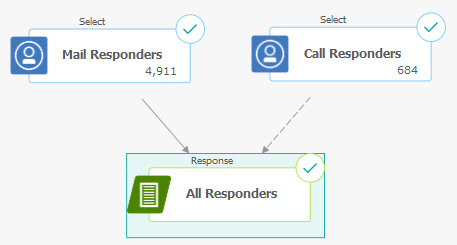How to track responses to a campaign
To perform response tracking, create a flowchart that includes the Response process. The Response process takes input from a Select or an Extract process and typically uses an action table as the source data.
Using an action table as input to the Response process
An action table is an optional database table or file containing response data that is collected after offers are presented to customers. There is usually one action table per audience level.
An action table usually serves as the source data of the input cell for the Response process. An action table is not required for response processing, but is considered a best practice.
An action table includes data such as customer identification, response codes, and attributes of interest. Depending on how responses are tracked in your organization, the responses could be directly related to transactional data, such as purchases or contracts and subscriptions.
When you use an action table as input to a Response process, the actions or events in the table are evaluated to see whether they should be attributed as responses to contact or control treatments. Unica Campaign reads from the action table, and if a match is found between the relevant attributes and/or response codes, Unica Campaign populates the response history tables for response tracking.
The Unica Campaign system tables include a sample action table for the Customer audience level, called UA_ActionCustomer. Administrators can customize the table as needed.
For important information about action tables, see the Unica Campaign Administrator's Guide.
How the Response process works
You configure the Response process in a flowchart to evaluate and output the IDs that you consider to be responses to your offer. The evaluation is done by matching some combination of response codes or other standard or custom offer attributes from the action table.
The response processing logic uses response codes of interest and response attributes of interest to determine direct and inferred responses:
- Response codes of interest: Any Unica Campaign-generated codes (campaign, offer, cell or treatment code) that are mapped in the Response process are considered to be "response codes of interest."
- Response attributes of interest: Any other offer attributes, whether standard or custom, that are mapped in the Response process are considered to be "response attributes of interest." For example, you can use the "Relevant Products" field as an offer attribute to track inferred responses.
Those responses are written to the response history system table (UA_ResponseHistory, or its equivalent for each audience level) when you run the Response process. There is one response history system table for each audience level that you are tracking.
The response history data is then available for use and analysis by the Unica Campaign performance reports.
The following example shows a simple flowchart that tracks responses to direct mail and telephone offers.
